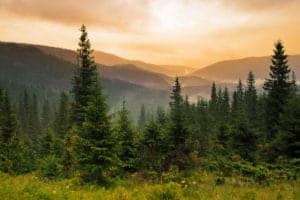Rural real estate is actually a conglomerate of several different markets—operating farms, hobby farms, recreational (undeveloped) land, principal residences, timberland, mineral lands, commercial properties and second homes.
It’s not uncommon, of course, for a single property to cross into more than one of these market segments. Timberland, for example, is frequently divided and marketed in large-lots for both second homes and as a timberland investment.
A database that would provide a reasonably precise statistical break out of rural real estate is not available. In the absence of a true census, economists are left with good-faith efforts and analyses of specific segments.
The National Association of Realtors (NAR) has sampled home buyers for a number of years. Each spring, NAR releases sale results and characteristics for primary residences, vacation properties and investment properties (held primarily for rental income). NAR considers the category of second homes to include both vacation properties and investment properties.
Americans bought about 553,000 vacation homes in 2009, about half of which were in the South. About 55 percent of that total were located in small towns and rural areas. Seventy percent were single-family, detached residences. The median price was $169,000, down from the 2005 high of $204,000, but up from 2008’s $150,000.
The 2009 total of vacation-property sales was a little better than half the number bought in 2005 and 2006, though it was almost an eight percent gain over 2008 vacation-property sales.
US Census Bureau data show a total of about 7.9 million vacation homes compared with about 75 million principal residences and 41 million investment properties.
I believe the actual number of second homes used primarily for vacationing, recreation, weekends and the like is higher than 7.9 million, because such places may be categorized and counted as small/hobby farms and hunting camps, or not counted at all.
The upper end of the vacation property market appears to be stronger than the lower end. Official unemployment among higher-income taxpayers is about three percent compared with about 10 percent overall.
My worries about rural second-home sales and vacation-home sales are these:
Credit. The attractive 30-year fixed-rate mortgages that everyone advertises are available to a relatively small number of borrowers who bring high credit scores, big down payments and conventional profiles for both themselves and their intended properties. Lenders, in my experience, continue to push borrowers into ARMs, whose renewal rates are likely to be higher than today. The Farm Credit Administration will make loans, but in my recent refi search, I found their fixed rate to be almost three points above the competition. Tight credit will put a cap on sales of all rural real estate, particularly second homes and investment properties.
Foreclosures and mortgage woes in primary residences. Second-home sales are related to trends in income, employment and conditions in the market for primary residences. To the extent the principal-residence mortgages are in trouble, second-home sales are likely to remain weak. When primary residence sales were flying high a few years ago, so were sales of vacation properties.
Almost 14 percent of all home borrowers had missed at least one payment or were in foreclosure at the end of last year—the seventh-straight quarterly increase. That’s about 2.4 million mortgages altogether—one million prime and about 1.4 million other-than-prime.(Nick Timiraos, “Foreclosures Ease, but More Borrowers Fall Behind,” Wall Street Journal, March 26, 2010; data from the U.S. Office of the Comptroller of the Currency and the Office of Thrift Supervision.)
While home sales have picked up a bit owing to hammered prices, we have not exited the multi-faceted mortgage mess that tumbled metropolitan sales and prices.
The high end of second-home sales is probably weaker than it was several years ago, though stronger than the low end and the mid range. Second-home properties that were traditionally pitched to the lower and middle segments will continue to be undercut by the continuing turmoil and pain in the overall mortgage market.
Prices anchored in the past. Vacation properties, particularly condo-type homes in Florida, California and the Southwest, have seen price declines of 25 to more than 50 percent. Asking-price declines of this magnitude have not appeared in most areas for country property—second homes, hobby farms and timberland. Rural properties were selling at highly contrived, inflated values in the 2005-2007 period. They didn’t make sense to me then, they make even less sense to me now.
Price has to reflect not only the intrinsic merits of the seller’s property, but the larger conditions within which the property is being marketed. These conditions — availability of credit, economic growth and employment, buyer optimism, taxes, interest rates – are, for the most part, not supporting seller asking prices for many rural properties. To the extent that rural sellers have to market against conditions, they have to lower their asking prices.
A market still exists for the lower and middle segments of rural real estates. It’s just that the price scales for these markets need to be shifted down to make them affordable.
This content may not be used or reproduced in any manner whatsoever, in part or in whole, without written permission of LANDTHINK. Use of this content without permission is a violation of federal copyright law. The articles, posts, comments, opinions and information provided by LANDTHINK are for informational and research purposes only and DOES NOT substitute or coincide with the advice of an attorney, accountant, real estate broker or any other licensed real estate professional. LANDTHINK strongly advises visitors and readers to seek their own professional guidance and advice related to buying, investing in or selling real estate.









Add Comment